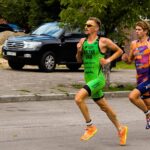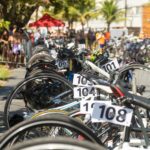This article is the first of three exploring the essential importance of intensity in triathlon training and racing. When most people think about intensity, they think about mental intensity, a certain seriousness and determination that they apply to their triathlon efforts. But that’s not what I’m talking about. When I say “intensity,” I mean the amount of physical activation you experience before and during training and races.

Intensity, as I define it, may be the most important contributor to triathlon performance once you arrive at the race venue. It’s so important because no matter how strong your other mental muscles are, whether motivation, confidence, focus, or mindset, they won’t help you if your body is not physiologically capable of doing what it needs to do for you to perform your best.
Simply put, intensity is the amount of physiological activity you experience in your body including heart rate, respiration, and adrenaline. Intensity is a continuum that ranges from sleep (very relaxed) to sheer terror (very anxious). Somewhere in between those two extremes is the level of intensity at which you perform your best.
The challenge with intensity is that there is not one ideal intensity for all triathletes. Depending on your physical and psychological make-up, you may perform best very relaxed, moderately intense, or bouncing off the walls with intensity.
The distance you race at can also impact how intensity affects you. Sprint- and Olympic-distance races may require higher intensity, while half- and full-Ironman races typically require lower intensity. Each segment of a triathlon may also require different levels of intensity. For example, you may need to be more intense for the swim, but moderately intense on the bike, and more relaxed on the run.
Intensity is made up of two components. First, there is the physical experience of intensity, that is, what you actually feel in your body when before and during races. Are you calm or nervous? Are you relaxed or tense? Second, there is your perception of the intensity. In other words, do you perceive the intensity positively or negatively? Two triathletes can feel the exact same thing physiologically, but interpret those physical feelings in very different ways. One may view the intensity as excitement and it will help his performance. Another may see the intensity as anxiety and it will hurt his performance. At the other end of the continuum, one triathlete may experience her low intensity as calm and another as lethargy.

The physical experience and the perception of intensity are affected by several mental factors. If you are not confident, feeling frustrated and angry, and focused on winning rather than on performing your best, you will see the intensity as negative. In contrast, if you are confident and positive, happy and excited, and focused on performing well, the intensity will be perceived as positive.
Prime intensity is that ideal level of physical activation required for you to perform your best in training and races. It includes just the right level of muscle activity, heart rate, blood flow, respiration and adrenaline. Additionally, prime intensity is perceived as positive and ideal. That good physiology also has a very positive influence on all aspects of your psychology.
Signs of Over- and Under-intensity
Intensity produces a wide variety of physical and mental symptoms that can help you recognize when your intensity is too high or too low. By being aware of these signs, you will be able to know when you’re not performing at prime intensity and can take steps to reach that ideal level (more on that in the third article in my series).
Overintensity. Muscle tension and breathing difficulties are the most common signs of overintensity. Most triathletes indicate that when they’re too intense, they feel tension in their shoulders and their legs, which happen to be the two most important physical areas for triathletes, though you can feel tension anywhere in your body. If a swimmer’s shoulders are tense, the motion of her strokes will shorten and she won’t be able to swim with ease or power. When a runner’s legs are tense, he loses the ability to run with smoothness and rhythm.
Many triathletes also report that their breathing becomes short and choppy when they get nervous. This restriction in breathing means that they’re not getting enough oxygen into their system so they will tire quickly. I’ve also found that the smoothness of triathletes’ movement tends to mirror their breathing. If your breathing is long and smooth, so is your movement. If your breathing is abrupt and uneven, your movements are jerky and uncomfortable.

Triathletes who are overly intense often exhibit poor posture and a stiff gait. Muscle tension causes their shoulders to rise and their body to seem to close up. Triathletes’ technique often suffers when they’re overly intense because anxiety disrupts coordination and flow. For example, your swim stroke or run stride may feel awkward. Triathletes who are anxious also increase the pace of the race. For example, an overly intense cyclist may go out too fast early in the bike leg and have nothing left for the run.
Overintensity negatively influences triathletes mentally as well. Anxiety lowers confidence and causes doubts in ability. The physical and mental discomfort produces negative emotions such as frustration, anger, and depression. The anxiety, doubts, and negative emotions hurt focus by drawing triathletes’ attention away from performing their best and onto how badly they feel.
Underintensity. Though not as common, triathletes can also experience underintensity during race. The most common symptoms of underintensity are low energy and lethargy. Triathletes lack the adrenaline they need to give their best effort. Though not as discomforting as overintensity, underintensity hurts performance equally because triathletes lack the physical requisites such as strength and endurance to meet the demands of triathlon.
Mentally, underintensity undermines motivation. Triathletes just don’t feel like being out there. The lack of interest caused by too low intensity also impairs their focus because they’re easily distracted and have difficulty staying focused on their race efforts.
Line Between Intensity and Tensity
The ultimate goal of prime intensity is to find the precise line between intensity (at which your body performs its best) and tensity (yes, that is actually a word; when performance declines). The closer you can get to that line, the more your body will work for you in performing your best. If you cross the line to tensity, your body will no longer be physically capable of high level of performance.
Great triathletes have the ability to do two things related to this line. First, they have a clear understanding of where that line is (i.e., their ideal intensity), so they find that line and “tightrope walk” on it, thereby maximizing what their bodies can give them. Second, they’re able to stay on that line longer and more consistently than other triathletes, which enables them to perform at a consistently higher level from start to finish.
In my next article in this three-part series, I’ll show you how to identify what your ideal intensity is based on past experience and by experimenting in your training.
Do you want to take the next step in training your mind to perform your best in training and on race day? Here are four options for you:
- Read my latest mental training book: Train Your Mind for Athletic Success: Mental Preparation to Achieve Your Sports Goals.
- Listen to my Train Your Mind for Athletic Success podcast.
- Take a look at my online mental training courses.
- Schedule a 1:1 session with me.






